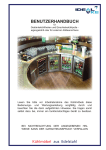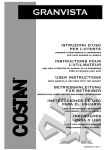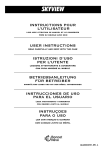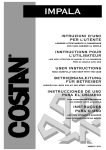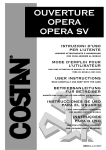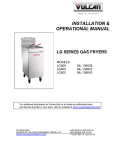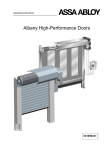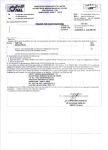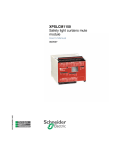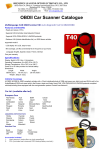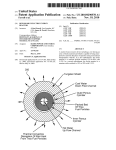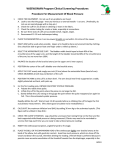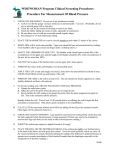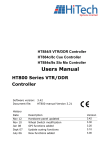Download User Manual
Transcript
OPERATION MANUAL for refrigerated counters for beverages embedded/stand alone self contained or remote refrigerated Please read this manual carefully before you start to operate your cooling equipment. Following these instructions will help you to ensure having a fully functional unit at all times. WARRANTY CLAIMS VOID IN CASE OF NON-OBSERVANCE THE FOLLOWING INSTRUCTIONS OR INAPPROPRIATE USE Kühlmöbel aus Edelstahl 2014 Contents 1 2 3 4 Introduction Welcome .........................................2 Warranty and liabilities ..................................2 Symbols and notes .............................2 2.1 2.2 2.3 2.4 Purpose of use General purpose of use Intended purpose of use Not intended purpose of use Safety notes 3.1 3.2 3.3 First steps Control of delivery .......................................4 Setting up ..........................................4 Installation of the unit ............................4 4.1 4.2 Safety instructions and technical data General safety regulations ...................................5 Technical data .........................................5 ........................3 .....................3 .................3 .................................3 5 Fundamental operating instructions 5.1 Starting up ..............................6 5.2 Switching on ................................6 5.3 Keys and functions ...............................6 5.4 Temperature settings ...............................7 5.5 Automatic defrosting ....................................7 5.6 Manually operated defrosting . . . . . . . . . . . . . . . . . . . . . . . . . . . . . . . . . . 7 5.7 Defrost water disposal ................................7 5.8 Loading ..........................................8 5.9 Notes on loading ........................8 5.10 Insertion of bottle dividers .......................9 5.11 Shutting down ............... ..................9 6 6.1 6.2 Cleaning and maintenance General recommendations . . . . . . . . . . . . . . . . . . . . . . . . . . . . . . 10 Detergents . . . . . . . . . . . . . . . . . . . . . . . . . . . . . . . . . . . . 10 7.1 7.2 7.3 7.4 Trouble shooting No function of the unit . . . . . . . . . . . . . . . . . . . . . . . 11 Insufficient temperature of the chilled goods . . . . . . . 11 Permanent icing of the evaporators . . . . . . . . . . . . . . . . . . . . . . . . . . . 11 Status and error messages on display . . . . . . . . . . 12 8.1 Dangers Electrical energy 9.1 9.2 9.3 Maintenance instructions Service and maintenance . . . . . . . . . . . . . . . . . . . . . . . . . . . . . . 13 Responsibilities of the operator . . . . . . . . . . . . . . . . . . . . . . . . . 13 Responsibilties of the service technician . . . . . . . . . . . . . . . . . . . . . . 13 7 8 9 10 11 page 1 1.1 1.2 1.3 . . . . . . . . . . . . . . . . . . . . . . . . . . . . . . . . . . 12 Spares and special equipment 10.1 Ordering spare parts . . . . . . . . . . . . . . . . . . . . . . . . . . . . . . . 14 10.2 Spare parts list . . . . . . . . . 14 CE declaration of conformity . . . . . . . . . . . . . . . . . . . . . . . . . . 15 All rights reserved 1.1 2014 1. Introduction Welcome With the purchase of this new refrigeration equipment you have decided on a product that combines the highest technical demands with practical service comfort. We recommend that you read these operating and maintenance instructions carefully in order to become familiar with the product quickly. With the intended treatment you will enjoy this appliance for a long time. Please keep these operating and maintenance instructions to consult in case any maintenance and repairs are needed. We wish you successful business and much pleasure by using this appliance! 1.2 Warranty and liabilties Fundamentally, our „General terms of sale and delivery“ are valid. These are known to the operator upon the signing of the contract at the latest. Claims of warranty and liability for damage to persons and property are not possible, if they result from one or several of the following causes: • not intended use of the unit • improper assembly, start up, operation and maintenance of the unit • operating the unit with defective safety devices or saftey devices which have not been installed properly and are not in working condition • disregard of the instructions in the operating manual concerning transportation, storage and installation • unauthorized mechanical or electrical changes to the unit • insufficient maintenance of wear and tear parts • unauthorized repairs • force of nature or acts of God, extreme environmental influences, fire, explosions, e.g. 1.3 Symbols and notes This symbol points to important references for the proper use of the unit. Not paying attention to these references can lead to a working disruption of the unit or to the environment! This danger symbol means a potential or direct threat to the life and health of persons and/or a possible dangerous situation. Ignoring these references may result in dire consequences for your health and/or can lead to property damages! This symbol points to operation tips and especially useful information of optimal use. Helps you to use all functions of your equipment optimal! All rights reserved page 2 2014 2. Purpose of use 2.1 General purpose of use This refrigeration equipment is specially designed for the fitting in bar counters (embedded or stand alone). It is produced for chilling bottled beverages of all kind and also, depending on version, for casks (EURO-KEG or DIN-KEG) up to 50 litres, at temperatures in a range of +2°C to +10°C. The unit is designed to climate classification 4 according to DIN EN ISO 23953. The declared values are valid for maximum ambient temperatures below +30°C and maximum 55% air humidity. THIS REFRIGERATING UNIT IS WORKING OPTIMAL WITH DOORS CLOSED. KEEP THE DOORS OPEN AS SHORT AS POSSIBLE. 2.2 Intended purpose of use The refrigeration units conform to current state-of-the-art technology. They are constructed in accordance with the recognized safety regulations and are reliable. However, health and/or life threatening circumstances could arise for the user or a third party or damage could be done to the appliance or other property or equipment should the unit be operated by non-trained personnel in a manner that is improper or in disregard of the regulations. The appliance may only be operated in a technically acceptable condition and in accordance with all regulations, safety regulations and with conscious regard of the operating instructions! Any other uses beyond those intended are to be considered as not being in compliance with the regulations. The manufacturer/supplier is not liable for any damages resulting from such actions. The user bears the entire risk. Use in accordance with the regulations includes observance of the mounting and operating instructions and keeping up with the inspection and maintenance regulations. After cleaning the appliance is to be checked for any loose connections, shears and damages. Any defects found should be repaired. The appliance is not to be used for non-operating purposes. Any changes to the appliance are to be made solely by the manufacturer! When replenishing the refrigerant only use the refrigerant indicated on the label. Refilling is to be carried out by authorized service personnel only. THE APPLIANCE WILL BE DESTROYED BY CHLOROUS OR SULPHUROUS AIR. 2.3 Not intended purpose of use The refrigeration unit is not suitable for cooling down beverages. No beverages having a significant higher temperature than the internal temperature are to be filled into the unit. Please load only with pre-chilled goods. An operation temperature of less than +2°C is not safe to operate! 2.4 Safety notes All safety regulations were followed during manufacturing, particularly the VDE regulations (Association for Electrical, Electronic & Information Technologies) and international CEE regulations. The appliance was subject to a comprehensive final check at the plant. page 3 All rights reserved 3.1 2014 3. First steps Control of delivery Checking for transport damage at the time of delivery is recommended. Any damages are to be recorded and confirmed in writing at the time of delivery and signed by the carrier. For any damages arising after unpacking, you are obliged to communicate this immediately in a written report and a telephone call to the supplier. Transport is covered under your responsibilities. Failing to report any transport damages with the carrier within the set time leads to the loss of responsibilities by the carrier! 3.2 Setting up Don’t tilt the refrigeration equipment during the installation, the compressor unit (only self contained units) could be damaged. Completely remove the plastic film before start up. Take care that the appliance is balanced and stands on a horizontal, stable and even ground. Accurate installation is necessary for a trouble-free start-up of the refrigeration equipment. Every installation has to fit to the local electric, safety and hygiene instructions: • please assemble the unit away from any heat sources or any places with direct sunlight • choose a place which is well ventilated and free of dust • the permanent room temperature must not exceed 30°C • the permanent air humidity must not exceed 55% PLEASE ENSURE THAT THE AIR-INTAKE AND OUTLET VENTS (GRILLE) FOR VENTILATION ARE WIDE ENOUGH AND MUST NEVER BE BLOCKED! OVERHEATING BY REASON OF BAD VENTILATION WILL DESTROY THE UNIT! It is recommended that the vents are 1.5 x the size of the condenser surface, but at least they must have the same width as the condenser of the refrigeration unit! Also the openings for the air circulation should be sized as big as possible (only for self contained units). 3.3 Installation of the unit A self contained unit can be installed by the operator. The refrigeration unit is provided with a 1.5 m long 3-wire power cord with plug and it may only be connected to a power socket with a nominal voltage 220-240 V / single phase / 50 cycles. The metal construction requires the use of a power socket with safety grounding at all times. The electrical power supply is to be secured with a max. 16 ampere circuit breaker (slow blow). For detailled information about technical data see the specification plate of the unit. The noise pressure level is < 70 dB(A). THE CONNECTION TO ANOTHER VOLTAGE OR FREQUENCY IS PERMITTED ONLY IF EXPRESSLY STATED ON THE SPECIFICATION PLATE ! THE INSTALLATION OF REMOTE REFRIGERATED UNITS HAS TO BE EXECUTED BY A REFRIGERATION SPECIALIST. All rights reserved page 4 2014 4. Safety instructions and technical data THE CONNECTIONS AND ANY TECHNICAL ADAPTATIONS ON THE REFRIGERATION EQUIPMENT ARE ONLY TO BE CARRIED OUT BY SPECIALISTS! THIS IS ESPECIALLY VALID FOR ANY WORK ON THE COOLING SYSTEM, ELECTRICAL INSTALLATION, WATER CONNECTION AND MECHANICAL WORK. ANY ADAPTATION HAS TO BE AUTHORIZED BY THE MANUFACTURER! 4.1 General safety regulations • those covers bearing a warning may only be opened by specialists! • protective covers and devices may not be removed due to risk of injury! • the control system may only be opened by an expert • the permanent surrounding temperature may not exceed 30°C • the relative humidity may not exceed 55% • due to risk of injury, sharp objects are not to be stored loosely in the refrigeration unit. • any components and operating equipment may only be replaced by genuine parts. 4.2 Technical data Power supply: Front protection: Safety class: Power consumption: Refrigeration capacity: Temperature range: Evaporation temperature: Max. ambient temperature : refrigerant (type): refrigerant (kg): Climate classification: MAWP: Noise pressure level: AC 220-240 V / 50 Hz IP22 I / safety earthing see specification plate see specification plate +2°C to +10°C -10 °C +30°C see specification plate see specification plate *) 4 according to DIN EN ISO 23953 30 bar < 70 db(A) (08.01.2014, technical data are subject to change) *) information available only for self contained units, for remote controlled units the filling with refrigerant will be executed by service partners on site page 5 All rights reserved 5.1 2014 5. Fundamental operating instructions Starting up After placement or moving the refrigeration unit, wait at least two hours before starting. This rest period is needed for the oil to run back into the compressor in case it could have shifted during transport (only for self contained units). Although we cleaned up the equipment after the assembly in our company we recommend cleaning the equipment with a suitable disinfectant before first start up (see `Cleaning and maintenance`) to remove residues or dirt from the installation. ALL PROTECTIVE FILM AND REMAINING GLUE HAVE TO BE REMOVED COMPLETELY BEFORE STARTING OPERATION 5.2 Switching on The refrigeration unit is switched on or off by pressing the green main switch. BY SAFETY REASONS THE UNIT WILL START OPERATION WITH A DELAY OF 1 MINUTE AFTER SWITCHING ON. Beside the main switch the display of the controller is arranged. The set-point temperature and possible error messages are displayed here. The factory setting for the temperature is +7 °C. After switching on the empty appliance it can take up to 1 hour until the desired temperature is reached. If the appliance is filled with goods this time can be extended up to 24 hours. The time until reaching the set temperature will also be influenced by the ambient conditions (surrounding temperature and humidity). ALLOW THE UNIT TO REACH ITS NORMAL OPERATING TEMPERATURE BEFORE LOADING WITH PRODUCT 5.3 Keys and functions button 1 button 2 button 3 button 4 SET LEFT RIGHT AUX main switch displays set point reduction of the desired set point temperature increasing of the desired set point temperature exit configuration menu 1 2 3 4 If the electronic display assembled in your appliance is different to the shown above (standard in this type), please consult your local refrigeration dealer for further information. All rights reserved page 6 2014 5. Fundamental operating instructions 5.4 Temperature settings The set point temperature can be displayed by pressing the button . Simultaneously pressing of and will lower the desired temperature, respectively the temperature will be risen by pressing of and . After resetting the temperature needs some time to pass before the desired temperature has been achieved. Please check the interior temperature a few hours afterwards with an exact thermometer and reset the thermostat if needed. The temperature setup should be made by a specialist during installation. ALL VALUES SHOULD BE SET PER SENSOR CALIBRATION BY A SPECIALIST BEFORE STARTING UP THE OPERATION. Depending on the ambient temperature and humidity, the interior temperature is not to be set too low as this could lead to icing of the cooling elements or condensing water on exposed areas. This will affect the cooling performance and anticipate the continuous defrosting which has been set by your specialized dealer for a certain interval. 5.5 Automatic defrosting The controller starts defrosting automatically in defined intervals (factory setting 4 hours). A defrosting operation is complete as soon as the pre-set temperature is reached at the evaporator or it will be stopped after 15 minutes. During defrost dF is shown on the display. MODIFICATIONS OF DEFROST DURATION AND FAN SPEED HAS TO BE DONE ONLY BY AUTHORISED SPECIALISTS 5.6 Manually operated defrosting Under special environmental effects the evaporator maybe is iced although automatically defrosting. Then the manually operated defrosting can be started at any time by pressing the button and simultaneously for 3 seconds. Alternatively you can also switch off the unit for defrosting for a few hours. Please note that sensible goods will not chilled in this period and it could be necessary to store them in another chilled place. 5.7 Defrost water disposal Accrued condensing water will be evaporated automatically via the waste heat of the cooling engine in self contained units. Remote refrigerated units have to be connected to the local waste water system via a waste trap. BY HYGIENE REASONS AND FOR AN EASIEST CLEANING WE RECOMMEND A CONDENSING WATER OUTLET ALSO FOR SELF CONTAINED REFRIGERATION UNITS (BY CUSTOMERS). page 7 All rights reserved 5.8 2014 5. Fundamental operating instructions Loading The appliance is designed to maintain the temperature of pre-chilled product. This refrigeration unit is not a refrigerator, and consequently, if warm product is filled in, there could be a considerable delay before the operating temperature falls to the normal operating level. The interior is basically designed for the storage of beverages. In exceptional situations you can also load other foodstuff, they have to be vacuum-packed or stored in air-tight sealed boxes. For the storage of loose foodstuff the special Gastronorm refrigerated counters are recommended to be used. LOOSE, ESPECIALLY ACIDIC FOODSTUFF CAN DESTROY STAINLESS STEEL SURFACES AND COOLING EQUIPMENT (EVAPORATOR, COPPERPIPES) INSIDE. THE MANUFACTURER IS NOT LIABLE FOR LOSS OF GOODS, EVEN IF THE APPLIANCE IS STILL COVERED BY WARRANTY. IT IS RECOMMENDED THAT THE TEMPERATURE OF THE APPLIANCE IS CHECKED PERIODICALLY. 5.9 Notes on loading Please pay attention that the goods are not placed to tight to the evaporator or block the airing. Else an optimal cooling of the goods will not be assured. The inside temperature of the unit is much more sensitive to changes than the stored goods. Their temperature will change with more delay. That means that by loading the unit with not pre-chilled goods the thermometer may display the desired temperature although the temperature of the goods is not the desired one yet. Depending on the sort of the chilled beverages attention has to be payed that the set temperature is not too cold. Else the liquids could freeze and the bottles may burst. ALL OPENINGS FOR AIR-CIRCULATION HAVE ALWAYS TO BE KEPT CLEAR BY HYGIENE REASONS THE STORAGE OF LOOSE OR UNSEALED FOODSTUFF IS NOT PERMITTED All rights reserved page 8 2014 5. Fundamental operating instructions 5.10 Insertion of bottle dividers The function of the bottle dividers is to prevent shifting and tumbling of the bottles. For assembling of the bottle dividers into the drawers please note the following: SIDE B SIDE A The bottle dividers have 2 different ends. The notch at „SIDE B“ is stepped to allow assembling, „Ende A“ has the same diameter as the bottle divider, to keep the divider firmly seated in the drawer. 1. 1. insert „SIDE A“ with an inclination of approx. 45° to one of the punched holes of the drawer. The notch has to face upwards. 2. move „SIDE B“ to an almost horizontal position now. 3. press the drawers sidewall panel carefully outwards and insert „SIDE B“ to the punched hole right opposite to „SIDE A“. To remove or to change the bottle dividers follow steps 1-3 in reversed order. 5.11 Shutting down The refrigeration unit is shut down by pressing the main switch or pulling the plug from the power socket. During the outage all doors and should be opened to provide the airing of the unit. Please remove all goods out of the inoperative unit. If you want to take the unit out of operation for a longer period we recommend a disinfecting of the interior. Make sure that the condensing water collection pan, arranged below the refrigeration system, is empty. If necessary remove the water with a sponge or cloth (only selfcontained units). Remove all goods out of the interior. Before reactivation of the unit it is necessary to check the interior for mould. Again a disinfecting is recommended. After long periods of standing idle it is necessary to consult an authorised service technician to grant a trouble free resumption of operation. page 9 All rights reserved 2014 6. Cleaning and maintenance The following is advice on maintenance, care, trouble shooting and service for your refrigeration equipment. The interior and the outside of the unit have to be cleaned every day in accordance with hygiene regulations. Only then you can assure an optimal storage of the goods. BEFORE YOU START TO CLEAN AND CARE SWITCH OFF THE APPLIANCE AND DISCONNECT IT FROM THE MAINS! 6.1 General recommendations The interior has to be cleaned weekly or in case of necessity (i.e. burst bottles, leaked out liquids, etc.). Special regard is to be given to the gaskets, their lifetime can be raised by a correct cleaning with solvent-free detergents. Use a special cleaning agent for stainless steel to keep the silk mat surface texture. Wear acid-proof gloves while cleaning the parts to prevent skin irritations. After cleaning with special cleaners you have to wash all parts with clear water and dry them so that there is no cleaner residue on these parts. It is absolutely necessary to bear some fundamental things in mind to keep this stainless steel refrigeration unit working and to maintain its long life: • always keep the stainless steel surfaces clean • never let the surface come into contact with rusty material 6.2 Detergents • Soapy water: use lukewarm soapy water for light dirt and all surfaces that are in contact with the chilled goods. This is adequate most times and treats the stainless steel with care. • Stainless-steel-cleaner: use standard stainless-steel-cleaners for extremely dirty surfaces. Do not use acid, bleaching, chlorine cleaners, inflammable detergents, high-pressure, water pressure or steam jet cleaning machines, sharp-edged or metallic tools like steel-wool or scrubbing cleanser for cleaning. NEVER USE SHARP- EDGED OR METALLIC TOOLS LIKE STEEL-WOOL OR SCRUBBING CLEANSER. ELSE STAINLESS STEEL AND COOLING COMPONENTS WILL BE DESTROYED. After cleaning the cooling unit has to be restored to its original condition to ensure a correct operation! In addition to the daily cleaning a periodically service and maintenance by authorised service technicians is required. All rights reserved page 10 2014 7. Touble shooting If the appliance doesn´t work or works incorrect, please check the following before requesting the customer service. Sometimes the problems can be solved easily by yourself. This will help you to avoid unnecessary costs. AFTER SWITCHING THE UNIT OFF AND ON AGAIN IN A SHORT INTERVAL THERE WILL BE A RESTART DELAY OF 1 MINUTE. 7.1 No function of the unit • the dedicated fuses are gone: check the fuses • the plug is not fitted correctly to the power socket or the power socket is broken: check the correct fitting of the plug or try another power socket • the main switch of the unit is OFF: press the main switch to ON - the lamp has to light green • the electronic controller is calibrated wrong or the display is dark: call an authorised service technician 7.2 Insufficient temperature of the chilled goods • the condenser is dirty: remove the airing cover from the engine compartment and clean the heat exchanger with a brush or a vacuum cleaner. • the ambient temperature is too high: Please assemble the unit away from any heat sources and also away from any places, where you will have direct sunshine. • too much or too warm goods: load only pre-chilled goods, keep the ventilation holes free. • the evaporator is overiced: start the manually defrost operation or switch off the unit for a few hours. Please note that sensible goods will not be chilled in this period and it could be necessary to store them in another chilled place. • malfunction of the refrigeriaton system or other installations: call a service technician. • the controller unit is decalibrated: call a service technician. 7.3 Permanent icing of the evaporators • defrost is not starting: start manually defrost. If this doesn´t put the thing right, call a service technician. • air circulation in the cold room is disturbed: keep the ventilation openings free and rearrange the chilled goods in a way that there is space enough for a proper air circulation. • the doors or drawers are opened too long: open the doors and drawers just if necessary and close them accurate. page 11 All rights reserved 7.4 2014 7. Trouble shooting Status and error messages on the display At the display of the controller you may see the following abbreviations. This will give you feedback about the status of the unit or error messages: • dF . . . . . . defrost is active (see 5.5) NON-OBSERVANCE OF ERROR MESSAGES MAY CAUSE SPOILAGE OF THE CHILLED GOODS. • HI • LO • E1 . . . . . . high temperature alarm (when several times repeated) . . . . . . low temperature alarm (when several times repeated) . . . . . . sensor failure or breakage IF THESE ERROR MESSAGES APPEAR DEFINITELY YOU HAVE TO CALL A SERVICE TECHNICIAN! If the causes of malfunction are not listed above, please consult your service partner! The serial number on the specification plate, which is usually mounted in the engine compartment or in the installation compartment, will allow your service partner to prepare the spare parts needed well directed. 8. Dangers 8.1 Electrical energy Switch off the appliance immediately when there are interruptions in the electrical power supply! Any work carried out on the electrical units or utilities may only be carried out in accordance with electrical regulations by an electrician specialist or by those being instructed and supervised by an electrician specialist. Appliances and unit components which are subject to inspection, maintenance and repair work have to be completely disconnected and volt-free. First, check whether the activated parts have indeed been disconnected and are volt-free, then ground and short them out. Insulate any adjacent parts that are also energized! WORKING ON PARTS WITH ELECTRICAL CURRENT IS DANGEROUS! All rights reserved page 12 2014 9. Maintenance instructions To ensure a trouble-free functionality of the refrigeration equipment it is obligatory to make a full technical and mechanical service at regular intervals. 9.1 Service and maintenance, trouble shooting • Prescribed adjustment, service and inspection work is to be completed timely by the manager or if necessary by an authorized service technician. • the operating personnel are to be informed before the beginning of the maintenance and service operations. • the unit has to be disconnected from the mains before maintaining, inspecting and repairing is performed; the main switch is to be guarded against unintended reclosing. • check all screw connections for tight fitting. • after finishing maintenance check all safety devices for proper functionality. 9.2 • • • • • • Responsibilities of the operator: complete cleaning of the entire refrigeration equipment checking the ventilator for functionality checking the temperature of the chilled goods checking the temperature of the unit checking and cleaning the drainage lines and defrost water tray cleaning the condensers on the refrigeration system (only self contained units) CLEAN THE CONDENSER WEEKLY WITH A BRUSH OR A VACUUM CLEANER WITH BRUSH ADAPTER. ALWAYS KEEP THE CONDENSER OF THE REFRIGERATION SYSTEM CLEAN. DIRT ON THE FINS CAN LEAD TO OVERHEATING AND DESTRUCTION OF THE UNIT! 9.3 • • • • page 13 Responsibilities of the service technician: checking the thermostat setting checking the amount of refrigerant test the cooling circuit for leaks making a security check of the unit All rights reserved 2014 10. Spares and special equipment Your refrigeration equipment meets the highest standards on quality and was designed especially for a long lasting usage. Anyhow it can not be excluded that defectives appear. Especially the gaskets are caught in a crossfire of influences. All single components are changeable and can be ordered as spare parts. 10.1 Ordering spare parts • Please contact your specialised refrigeration service company for ordering spare parts. Of course you can order the spares also via any other specialised dealer in your surrounding. • Each appliance has a specification plate with a serial number. It is regularly mounted in the interior below the top of the unit or inside the installation/engine compartment. The information about the units data will help your dealer to provide you an effective service. • The date of manufacturing and the type designation are important for the allocation and therefore a quick procession of your order. • the same applies especially for gaskets: the date of manufacturing and the exact dimensions of the gaskets will help to proceed your order quickly. THE CORRECT ALLOCATION BY THE SPECIFICATION PLATE MAKES THE PROCESSING OF SPARE PARTS ORDERS FAST AND EASILY. 10.2 Detailled list of spares and special equipment • spare parts blind for engine compartment width 330 mm blind for engine compartment width 380 mm Art. Nr. 193 000 193 001 • special equipment bottle divider for drawer height adjustable additional shelf with fixture device 190 020 190 300 All rights reserved page 14 2014 11. CE declaration of conformity file name: OM_EKP 2014-1.indd storage location: F:\MEDIENSUPPORT\HANDBÜCHER\INDESIGN Version: 2014-1, date 08.01.2014 © Ideal Kältetechnik GmbH technical data are subject to change
















